
The formation of the Iberian civilisation
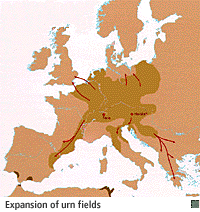 In about 1000 BCE, there came a people from the other side of the Pyrenees who spoke an Indo-European language and knew of the iron metallurgy because of their origins in the area of the Danube, in the middle of Europe.
In about 1000 BCE, there came a people from the other side of the Pyrenees who spoke an Indo-European language and knew of the iron metallurgy because of their origins in the area of the Danube, in the middle of Europe.
They overran the natives of the country, whose material culture was of bronze, and who had never experienced any foreign influence, being, in fact, survivors of the prehistoric Neolithic population.
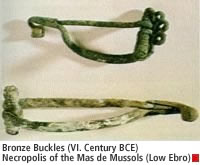 Apart from language, these people from the Centre of Europe brought a new burial ritual, the incineration or cremation of the bodies, the ashes of which were put directly into pottery urns under the earth. This act gave them the name of ”people of fields of urns”. It must be clarified that the metallurgy of iron was introduced very slowly, and was not completely implanted until the VI Century BCE, when it was not only used for prestigious objects, but also for agricultural instruments and other tools of everyday use. The widespread use is related to the presence of Greek merchants in the region of the Emporda.
Apart from language, these people from the Centre of Europe brought a new burial ritual, the incineration or cremation of the bodies, the ashes of which were put directly into pottery urns under the earth. This act gave them the name of ”people of fields of urns”. It must be clarified that the metallurgy of iron was introduced very slowly, and was not completely implanted until the VI Century BCE, when it was not only used for prestigious objects, but also for agricultural instruments and other tools of everyday use. The widespread use is related to the presence of Greek merchants in the region of the Emporda.
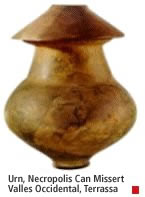 Bronze was designated for objects of dressing table like small knives, or for decorative and surgical use. The change of the material culture would also be felt in the shapes and decoration of pottery, the urns usually had biconical forms with careened or rounded bodies with covers in the shape of a dish with a flat base. The decoration is basically striating, overlapping decorated cords and incised geometric motifs.
Bronze was designated for objects of dressing table like small knives, or for decorative and surgical use. The change of the material culture would also be felt in the shapes and decoration of pottery, the urns usually had biconical forms with careened or rounded bodies with covers in the shape of a dish with a flat base. The decoration is basically striating, overlapping decorated cords and incised geometric motifs.
The houses of the newly arrived people are huts dug out of the earth, with a wood and clay covering help up by sticks in the ground. They have small dimensions and might be oval or rectangular.
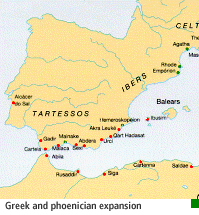 But the arrival of the people of the fields of urns is not enough to explain the formation of the Iberian culture. An equally or more transcendent event is thefrequent commercial trips which began about the same time all along our coasts by seagoing peoples from the Eastern Mediterranean, the Phoneticians and Greeks, or Central Mediterranean, the Etruscans.The foundation of the colony of Phocea in Empúries in the Gulf of Roses was decisive, connected to the factory of Marseille (Massalia) which had the same origin in about 600 BCE. Previouslythe Greeks of the island of Rhodes had established the town with same the name only a little more to the North, where the town of Roses is today.
But the arrival of the people of the fields of urns is not enough to explain the formation of the Iberian culture. An equally or more transcendent event is thefrequent commercial trips which began about the same time all along our coasts by seagoing peoples from the Eastern Mediterranean, the Phoneticians and Greeks, or Central Mediterranean, the Etruscans.The foundation of the colony of Phocea in Empúries in the Gulf of Roses was decisive, connected to the factory of Marseille (Massalia) which had the same origin in about 600 BCE. Previouslythe Greeks of the island of Rhodes had established the town with same the name only a little more to the North, where the town of Roses is today.
The Rhodesians were the inheritors of Phoenician trade to the Mediterranean when that nation fell under the power of AssyrianImperialism.
 Texts written in Greek, together with archaeology, teach us about those distant times in our history They tell us that the settlement of Rhodes in the Emporda took place before the first Olympic Games, meaning the IX. Century BCE, since the first Olympic game was the year 776 BCE, although archaeology has not yet been able to confirm that distant date.
Texts written in Greek, together with archaeology, teach us about those distant times in our history They tell us that the settlement of Rhodes in the Emporda took place before the first Olympic Games, meaning the IX. Century BCE, since the first Olympic game was the year 776 BCE, although archaeology has not yet been able to confirm that distant date.
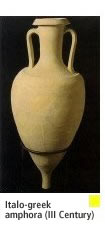 The Etruscans also frequented the meridional and northern coast of Catalonia, the delta of the river Ebro and the Emporda, and like the Phoenicians and Greeks, the natives of the country opened their doors to them as they brought two highly prized and very different products unknown locally - iron and wine.
The Etruscans also frequented the meridional and northern coast of Catalonia, the delta of the river Ebro and the Emporda, and like the Phoenicians and Greeks, the natives of the country opened their doors to them as they brought two highly prized and very different products unknown locally - iron and wine.
All the elements brought by these foreign people: Indo-Europeans, Phoenicians, Rhodesians, Etruscans and Phoceans whether of a material nature, such as the potter’s wheel or iron metallurgy, or of a more cultural character like writing and the alphabet demonstrate the process of acculturation which the native population was undergoing before later emerging as the superior civilisation we now know as Iberian.
The name “Iberian” was given by the Greeks to all the tribes along the peninsula’s Mediterranean seaboard, perhaps due to the importance of the River Iberus, the Ebro, a huge body of water which must have surprised people coming from lands without rivers.
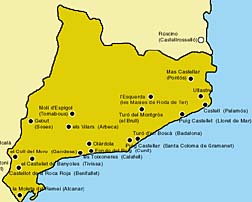 Iberian culture would come into being around the mid-VI Century BCE and, dependent on the native substratum and their proximity to colonial coastal nuclei, we can find differing aspects: there are differences not only between the coastal Levantine and Andalusian tribes, but also within Catalonia, where we can see differences between coastal and inland regions, since the distribution ofthese Iberian peoples was based on compartmentalization into natural autonomous regions.
Iberian culture would come into being around the mid-VI Century BCE and, dependent on the native substratum and their proximity to colonial coastal nuclei, we can find differing aspects: there are differences not only between the coastal Levantine and Andalusian tribes, but also within Catalonia, where we can see differences between coastal and inland regions, since the distribution ofthese Iberian peoples was based on compartmentalization into natural autonomous regions.
Iberian civilisation in Catalonia can be divided into three phases: ancient Iberian, from the mid-VI to the mid- V Centuries BCE; the Middle Iberian period from then up to the beginning of the II Century BCE (the time of the Roman conquest) and the Iberian-Romans, from that time until they disappeared, absorbed into the Roman culture. Iberian culture also took shape in what is today Northern Catalonia, as far as the Erau (Hérault) River, where the tribes of the Elisics were, in the Narbonne area, and the Sordones, in the Rousillon region, and almost certainly as far as Cap de CreusOn the other side of the Albera Mountains, the Indiketes lived on the Emporda plain, and going down the coast, these were followed by the Laietans, from Blanes to the South of Barcelona, as well as occupying Vallès, the Cossetans in the Penedes and the Camp de Tarragona and the Ilercavons on the coast of Tarragona and as far as the Castellón plain.
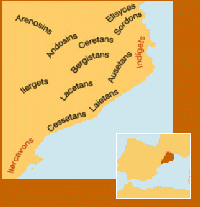 In Central Catalonia there were the Lacetans and the Ausetans in Bages and Osona, but the most important of the tribes of inland Catalonia were the Ilergets, who had allied with the Carthaginians in theIII Century BCE when the latter were fighting the Romans on our land. They dominated from their base inIlerda (Lerida), a territory which included all of Urgell as far as Osca, and the lower reaches of the Ebro.
In Central Catalonia there were the Lacetans and the Ausetans in Bages and Osona, but the most important of the tribes of inland Catalonia were the Ilergets, who had allied with the Carthaginians in theIII Century BCE when the latter were fighting the Romans on our land. They dominated from their base inIlerda (Lerida), a territory which included all of Urgell as far as Osca, and the lower reaches of the Ebro.
In the Pyrennees, the Andosins lived in Andorra, the Bergistans in Bergeda, the Airenosins in the Vall d’Aran and the Ceretans in Cerdanya, neighbours of the Indiketes and the Sordones, on the coast.